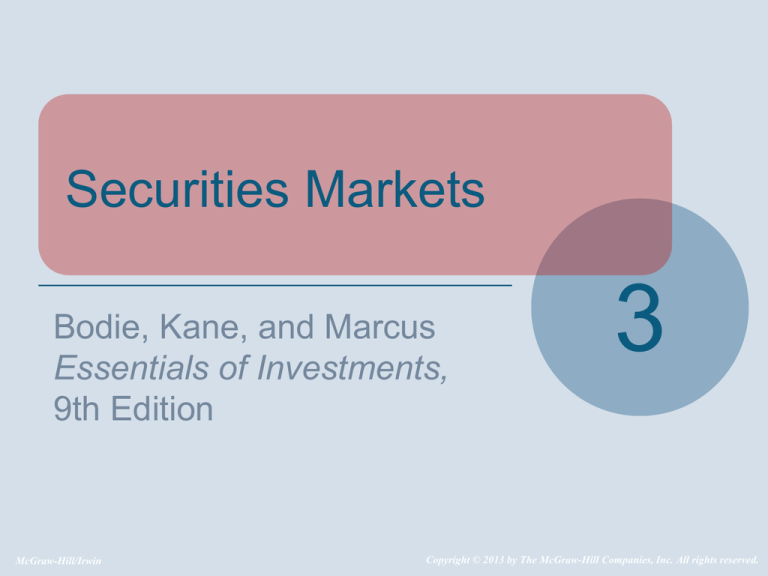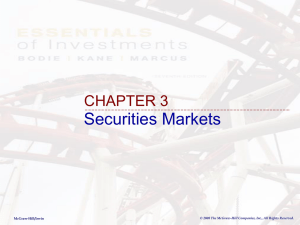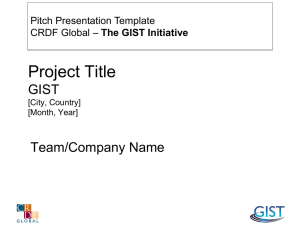
Securities Markets
Bodie, Kane, and Marcus
Essentials of Investments,
9th Edition
McGraw-Hill/Irwin
3
Copyright © 2013 by The McGraw-Hill Companies, Inc. All rights reserved.
3.1 How Firms Issue Securities
• Primary vs. Secondary Market Security Sales
• Primary
• New issue created/sold
• Key factor: Issuer receives proceeds from sale
• Public offerings: Registered with SEC; sale made to
investing public
• Private offerings: Not registered; sold only to limited
number of investors with restrictions on resale
• Secondary
• Existing owner sells to another party
• Issuing firm doesn’t receive proceeds, is not directly
involved
3-2
3.1 How Firms Issue Securities
• Privately Held Firms
• Up to 499 shareholders
• Fewer obligations to release financial
statements to public
• Private placement: Primary offerings sold
directly to a small group of investors
3-3
3.1 How Firms Issue Securities
• Publicly Traded Companies
• Sell securities to the general public; allow
investors to trade shares in securities markets
• Initial public offering: First sale of stock by a
formerly private company
• Underwriters: Purchase securities from issuing
company and resell them
• Prospectus: Description of firm and security
being issued
3-4
Figure 3.1 Relationship among a Firm Issuing Securities, the
Underwriters, and the Public
3-5
3.1 How Firms Issue Securities
• Shelf Registration
• SEC Rule 415
• Security is preregistered and then may be
offered at any time within the next two years
• 24-hour notice: Any or all of preregistered
amount may be offered
• Introduced in 1982
• Allows timing of issues
3-6
3.1 How Firms Issue Securities
• Initial Public Offerings
• Issuer and banker put on “road show”
• Purpose: Bookbuilding and pricing
• Underpricing
• Post-initial sale returns average 10% or
more—“winner’s curse” problem?
• Easier to market issue; costly to issuing firm
3-7
Figure 3.2 Average First-Day Returns for European IPOs
3-8
Figure 3.2 Average First-Day Returns for Non-European
IPOs
3-9
3.2 How Securities Are Traded
• Functions of Financial Markets
• Overall purpose: Facilitate low-cost investment
• Bring together buyers and sellers at low cost
• Provide adequate liquidity by minimizing time
and cost to trade and promoting price
continuity
• Set and update prices of financial assets
• Reduce information costs associated with
investing
3-10
3.2 How Securities Are Traded
• Types of Markets
• Direct Search Markets
• Buyers and sellers locate one another on their own
• Brokered Markets
• Third-party assistance in locating buyer or seller
• Dealer Markets
• Third party acts as intermediate buyer/seller
• Auction Markets
• Brokers and dealers trade in one location
• Trading is more or less continuous
3-11
3.2 How Securities Are Traded
• Types of Orders
• Market order: Execute immediately at best price
• Bid price: price at which dealer will buy security
• Ask price: price at which dealer will sell security
• Price-contingent order: Buy/sell at specified price
or better
• Limit buy/sell order: specifies price at which
investor will buy/sell
• Stop order: not to be executed until price point
hit
3-12
Figure 3.3 Average Market Depth for Large (S&P 500) and Small
(Russel 2000) Firms
3-13
Figure 3.4 Limit Order Book for Intel on the NYSE Arca Market,
July 22, 2011
3-14
3.2 How Securities Are Traded
• Trading Mechanisms
• Dealer markets
• Over-the-counter (OTC) market: Informal network of
brokers/dealers who negotiate securities sales
• NASDAQ stock market: Computer-linked price quotation
system for OTC market
• Electronic communication networks (ECNs)
• Computer networks that allow direct trading without market
makers
• Specialist markets
• Specialist: Makes market in shares of one or more firms;
maintains “fair and orderly market” by dealing personally
3-15
Figure 3.5 Price-Contingent Orders
3-16
3.3 The Rise of Electronic Trading
• Timeline of Market Changes
• 1969: Instinet (first ECN) established
• 1975: Fixed commissions on NYSE eliminated
• Congress amends Securities and Exchange Act
to create National Market System (NMS)
• 1994: NASDAQ scandal
• SEC institutes new order-handling rules
• NASDAQ integrates ECN quotes into display
• SEC adopts Regulation Alternative Trading
Systems, giving ECNs ability to register as stock
exchanges
3-17
3.3 The Rise of Electronic Trading
• Timeline of Market Changes
• 1997: SEC drops minimum tick size from 1/8 to
1/16 of $1
• 2000: National Association of Securities Dealers
splits from NASDAQ
• 2001: Minimum tick size $.01
• 2006: NYSE acquires Archipelago Exchanges and
renames it NYSE Arca
• SEC adopts Regulation NMS, requiring
exchanges to honor quotes of other exchanges
3-18
Figure 3.6 Effective Spread vs. Minimum Tick Size
3-19
3.4 U.S. Markets
• NASDAQ
• Approximately 3,000 firms
• New York Stock Exchange (NYSE)
• Stock exchanges: Secondary markets where
already-issued securities are bought and sold
• NYSE is largest U.S. Stock exchange
• ECNs
• Latency: Time it takes to accept, process, and
deliver a trading order
3-20
Figure 3.7 Market Share of Trading in NYSE-Listed Shares
3-21
3.5 New Trading Strategies
• Algorithmic Trading
• Use of computer programs to make rapid
trading decisions
• High-frequency trading: Uses computer
programs to make very rapid trading decisions
in order to compete for very small profits
• Dark Pools
• ECNs where participants can buy/sell large
blocks of securities anonymously
• Blocks: Transactions of at least 10,000 shares
3-22
Figure 3.8 Market Capitalization of Major World Stock
Exchanges, 2011
3-23
3.6 Globalization of Stock Markets
• Moving to automated electronic trading
• Current trends will eventually result in 24-
hour global markets
• Moving toward market consolidation
3-24
3.7 Trading Costs
• Commission: Fee paid to broker for making
transaction
• Spread: Cost of trading with dealer
• Bid: Price at which dealer will buy from you
• Ask: Price at which dealer will sell to you
• Spread: Ask — bid
• Combination: On some trades both are
paid
3-25
3.8 Buying on Margin
• Margin: Describes securities purchased
with money borrowed in part from broker
• Net worth of investor's account
• Initial Margin Requirement (IMR)
• Minimum set by Federal Reserve under
Regulation T, currently 50% for stocks
• Minimum % initial investor equity
• 1 − IMR = Maximum % amount investor can
borrow
3-26
3.8 Buying on Margin
• Equity
• Position value – Borrowing + Additional cash
• Maintenance Margin Requirement (MMR)
• Minimum amount equity can be before
additional funds must be put into account
• Exchanges mandate minimum 25%
• Margin Call
• Notification from broker that you must put up
additional funds or have position liquidated
3-27
3.8 Buying on Margin
• If Equity / Market value MMR, then
margin call occurs
• (Market value – Borrowed) / Market Value
MMR; solve for market value
• A margin call will occur when:
• Market value = Borrowed/(1 − MMR)
3-28
3.8 Buying on Margin
• Margin Trading: Initial Conditions
• X Corp: Stock price = $70
• 50%: Initial margin
• 40%: Maintenance margin
• 1000 shares purchased
Initial Position
Stock
$70,000
Borrowed
$35,000
Equity
$35,000
3-29
3.8 Buying on Margin
• Stock price falls to $60 per share
• Position value – Borrowing + Additional cash
• Margin %: $25,000/$60,000 = 41.67%
• How far can price fall before margin call?
• Market value = $35,000/(1 – .40) = $58,333
New Position
Stock
$60,000
Borrowed
$35,000
Equity
$25,000
3-30
3.8 Buying on Margin
• With 1,000 shares, stock price for margin
call is $58,333/1,000 = $58.33
• Margin % = $23,333/$58,333 = 40%
• To restore IMR, equity = ½ x $58,333 = $29,167
New Position
Stock
$60,000
Borrowed
$35,000
Equity
$23,333
3-31
3.8 Buying on Margin
• Buy at $70 per share
• Borrow at 7% APR interest cost if using margin;
use full amount margin
• APRs (365-day year)
Buy at $70
Sell at $72 in
90 days
Sell at $68 in
90 days
No margin
11.59%
−11.59%
Margin
16.17%
−30.17%
Leverage factor
1.4x
2.6x
3-32
Table 3.1 Illustration of Buying Stock on Margin
3-33
3.9 Short Sales
• Sale of shares not owned by investor but
borrowed through broker and later purchased
to replace loan
• Mechanics
• Borrow stock from broker; must post margin
• Broker sells stock, and deposits proceeds/margin
in margin account (you cannot withdraw proceeds
until you “cover”)
• Covering or closing out position: Buy stock; broker
returns title to party from which it was borrowed
3-34
3.9 Short Sales
• Round Trips
• Long position
• Buy first, sell later
• Bullish
• Short position
• Sell first, buy later
• Bearish
• “Round trip” is a purchase and a sale
3-35
3.9 Short Sales
• Required initial margin: Usually 50%
• More for low-priced stocks
• Liable for any cash flows
• Dividend on stock
• Zero tick, uptick rule
• Eliminated by SEC in July 2007
3-36
3.9 Short Sales
• Short-sale maintenance margin
requirements (equity)
Price
MMR
< $2.50
$2.50
$2.50-$5.00
$5.00-$16.75
> $16.75
100% market value
$5.00
30% market value
3-37
3.9 Short Sales
• Example
• You sell 100 short shares of stock at $60 per
share
• $6,000 must be pledged to broker
• You must also pledge 50% margin
• You put up $3,000; now you have $9,000 in
margin account
• Short sale equity = Total margin account –
Market value
3-38
3.9 Short Sales
• Example
• Maintenance margin for short sale of stock with
price > $16.75 is 30% market value
• 30% x $6,000 = $1,800
• You have $1,200 excess margin
• What price for margin call?
3-39
3.9 Short Sales
• Example
• When equity (.30 x Market value)
• Equity = Total margin account – Market value
• When Market value = Total margin account / (1
+ MMR)
• Market value = $9,000/(1 + 0.30) = $6,923
• Price for margin call: $6,293/100 shares =
$69.23
3-40
3.9 Short Sales
• Example
• If this occurs:
• Equity = $9,000 − $6,923 = $2,077
• Equity as % market value = $2,077/$6,923 =
30%
• To restore 50% initial margin:
• ($6,923/2) − $2,077 = $1,384.50
3-41
Table 3.2 Cash Flows from Purchasing vs. Short-Selling
Purchase of Stock
Time
Action
Cash Flow*
0
Buy share
− Initial price
1
Receive dividend, sell share
Ending price + Dividend
Profit = (Ending price + Dividend) – Initial price
Short Sale of Stock
Time
Action
Cash Flow*
0
Borrow share; sell it
+ Initial price
1
Repay dividend and buy share to
replace share originally borrowed
− (Ending price + Dividend)
Profit = Initial price – (Ending price + Dividend)
*Note: A negative cash flow implies a cash outflow.
3-42
3.10 Regulation of Securities Markets
• Self-Regulation
• The Sarbanes-Oxley Act
• Insider Trading
• Inside information: Nonpublic knowledge about
a corporation possessed by officers, major
owners, etc., with privileged access to
information
3-43
Selected Problems
3-44
3-44
Chapter 3: Problem 1
a. Explicit and Implicit costs.
Explicit: Underwriter’s Fee $70,000
Implicit: Underpricing
($53 -$50) x 100,000 = $300,000
Total Costs = $370,000
b. No. The underwriters did not directly profit
from the underpricing of the securities.
3-45
Chapter 3: Problem 2
a. If the price keeps going up your losses are
unlimited.
b.
The stop-buy order at $128 limits your max loss to about $8 per share.
3-46
Chapter 3: Problem 3
a. The stock is purchased for: 300 $40 = $12,000
The amount borrowed is $4,000.
Therefore, the investor put up equity, or margin, of $8,000.
3-47
Chapter 3: Problem 3
b. If the share price falls to $30, then the value of the stock
falls to $30 x $300 = $9,000. By the end of the year, the
amount of the loan owed to the broker grows to:
$4,000 1.08 = $4,320
Therefore, the remaining equity in the investor’s account is:
$9,000 $4,320 = $4,680
The percentage margin is now: __________________________
$4,680 / $9,000 = 0.52 = 52%
Therefore the investor will not receive a margin call.
3-48
Chapter 3: Problem 3
c. The rate of return on the investment over the year is:
Beginning Equity = $8,000
End Equity = $4,680
(Ending equity in the account Initial equity) / Initial equity
HPR = ($4,680 $8,000) / $8,000 = 0.415 = 41.5%
3-49
Chapter 3: Problem 4
Many exchanges and the ECNs have pretty much
eliminated market-making specialists.
Here the computer finds the best prices to make
the trades.
3-50
Chapter 3: Problem 5
a. $50.25
b. $51.50
c. You should probably increase your position.
There is plenty of buying demand at prices just
below $50, so downside risk is limited. The limit
sell orders are less concentrated.
3-51
Chapter 3: Problem 6
a. You buy $10,000/$50= 200 shares
Shares go up 10% $50$55 $55 X 200=$6000
You pay interest .08 X $5000 = $400
Rate of return = 6000 – 400 – 5000 = 12%
5000
b. The margin call will occur when
Market Value = Amount Borrowed / (1 - MMR)
/ (1 – 0.30) = $7,142.86
Market Value $5,000
=
$7,142.86
/ 200 shares = $35.71
Stock price
=
3-52
Chapter 3: Problem 7
a. 55.50
b. 55.25
c. The trade will not be executed because the bid price
is lower than the price specified in the limit sell order.
d. The trade will not be executed because the ask price
is greater than the price specified in the limit buy order.
3-53
Chapter 3: Problem 8
a. In an exchange market, there can be price improvement
in the two market orders. Brokers for each of the market
orders (i.e., the buy and the sell orders) can agree to
execute a trade inside the quoted spread.
• For example, they can trade at $55.37, thus improving
the price for both customers by either $0.12 or $0.13
relative to the quoted bid and asked prices.
3-54
Chapter 3: Problem 8
b. Whereas the limit order to buy at $55.37 would not be
executed in a dealer market (since the asked price is
$55.50), it could be executed in an exchange market.
• A broker for another customer with a market sell
order would view the limit buy order as the best bid
price; the two brokers could agree to the trade and
bring it to the specialist, who would then execute the
trade.
3-55
Chapter 3: Problem 9
Note that your profit ($200) equals (100 shares profit per share of $2). Your net proceeds
per share was:
$14
–$ 9
–$ 2
–$ 1
$ 2
selling price of stock
repurchase price of stock
dividend per share
2 trades $0.50 commission per share
(Round Trip)
3-56
Chapter 3: Problem 10
d. Cannot tell from the information given. The
broker will attempt to sell after the first
transaction at $55 or less.
3-57










